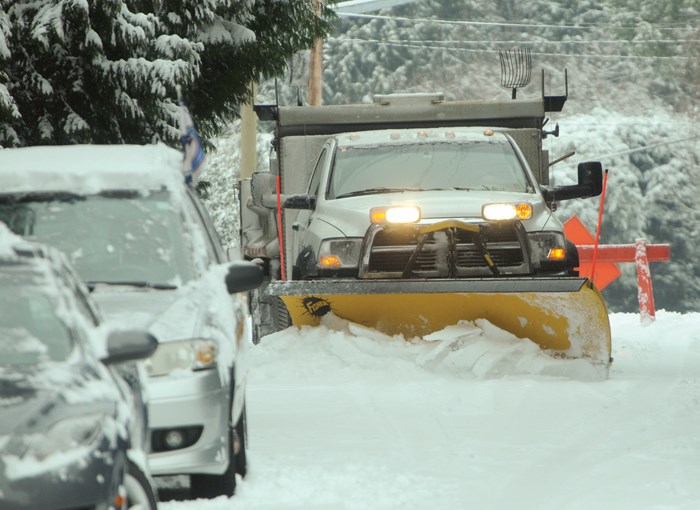The North Shore’s three municipalities had a snowplow drive through their 2016/2017 snow removal budgets thanks to a merciless winter.
With the first day of spring now in the rearview mirror and no more of the white menace in the forecast, local governments have a rough accounting of how much more this year cost than most.
The District of North Vancouver’s snow clearing costs almost tripled their budget of $600,000, as the municipality spent $1.8 million on plowing, salting, brining and maintenance of the fleet.
Snow removal costs at the District of West Vancouver came in just under $1.15 million, almost double their anticipated budget of $606,000.
And the City of North Vancouver overshot last year’s snow removal costs seven fold, at $930,000.
Between December and March, the District of North Vancouver’s fleet of 12 trucks plowed and brined about 70,000 kilometres on the district’s 350 kilometres of roads.
“It was a very, very unusual year for us,” district engineering manager Gavin Joyce said with a laugh. “I think those numbers, $1.8 million, would suggest we were throwing everything and the kitchen sink at it.”
The only other comparable winter in recent memory was in 2008/2009 when snow removal cost between $1.8 and $1.9 million, Joyce said.
The municipalities will have to dip into reserves to make up the difference, Joyce said. “There’s a startup cost, if you will, even if you don’t have any snow and beyond that, it’s Mother Nature and she will determine how many times we’re out and what we do.”
While those numbers may seem high, our balmy climate shields us from the expensive realities of the Canadian winter most municipalities must deal with, Joyce added.
Despite some hellish morning and afternoon commutes, the district received mostly positive comments from the public, Joyce said.
“I would say our positive comments easily outweighed our negative ones,” he said.
Joyce and district Mayor Richard Walton recently made a trip to the municipal operations centre to thank the snow removal crews. “I think they did a fantastic job this year,” Joyce said.
All three municipalities prioritize arterial roads, transit and emergency routes following a snowfall, but this year’s efforts were hampered by large dumps of snow happening just prior to rush hour, said city spokeswoman Connie Rabold in an email. Many drivers also opted to head out into the snow using their summer or all-season tires, Rabold added, although even TransLink’s buses were often no match for local topography in slick conditions.
Notwithstanding the bad winter, the city was already in the process of purchasing new snow and ice equipment as part of the fleet planning process, which will mean two more large trucks on the road for winter of 2017/2018.
This spring will also likely come with higher road patching costs, thanks to winter weather bringing more potholes, Rabold said.
While the district doesn’t have specific plans to buy more plows, climate change and extreme weather events have to be accounted for in budgeting, Joyce said.
“What are the weather patterns now? How is this changing?” he asked. “We’ve had two years in 15 like this but are we now going to see this every two years or every three years? If that’s the case, we would have to look at the equipment and the manpower and service levels.”
During one nasty storm in February, West Vancouver staff posted a message to their website asking residents to stop calling to request their streets be cleared. All told, it was an exceptional year, said Jeff McDonald, West Vancouver spokesman.
“This past winter was quite extreme in terms of snowfall. People need to understand that responding to extreme weather events is expensive. Our roads staff did a good job things moving and keeping people safe,” he said.



